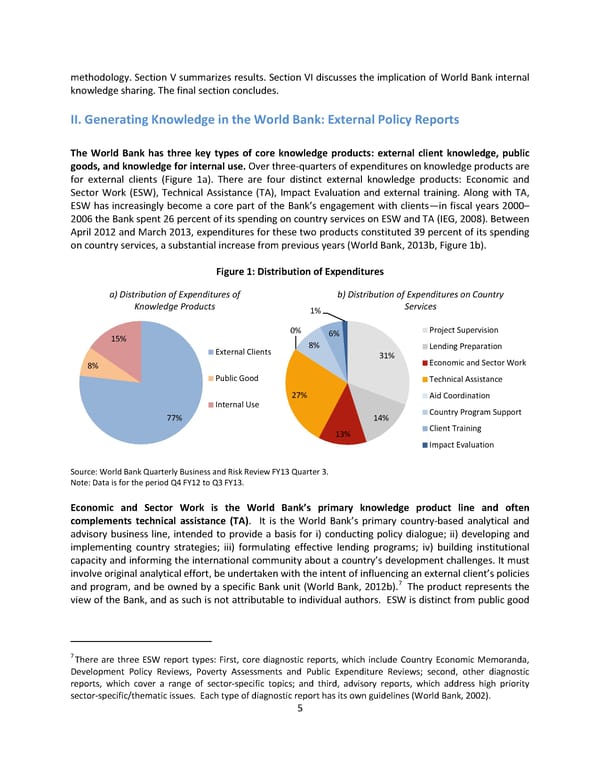methodology. Section V summarizes results. Section VI discusses the implication of World Bank internal knowledge sharing. The final section concludes. II. Generating Knowledge in the World Bank: External Policy Reports The World Bank has three key types of core knowledge products: external client knowledge, public goods, and knowledge for internal use. Over three-quarters of expenditures on knowledge products are for external clients (Figure 1a). There are four distinct external knowledge products: Economic and Sector Work (ESW), Technical Assistance (TA), Impact Evaluation and external training. Along with TA, ESW has increasingly become a core part of the Bank’s engagement with clients—in fiscal years 2000– 2006 the Bank spent 26 percent of its spending on country services on ESW and TA (IEG, 2008). Between April 2012 and March 2013, expenditures for these two products constituted 39 percent of its spending on country services, a substantial increase from previous years (World Bank, 2013b, Figure 1b). Figure 1: Distribution of Expenditures a) Distribution of Expenditures of b) Distribution of Expenditures on Country Knowledge Products 1% Services 0% 6% Project Supervision 15% 8% Lending Preparation External Clients 31% 8% Economic and Sector Work Public Good Technical Assistance 27% Aid Coordination Internal Use Country Program Support 77% 14% 13% Client Training Impact Evaluation Source: World Bank Quarterly Business and Risk Review FY13 Quarter 3. Note: Data is for the period Q4 FY12 to Q3 FY13. Economic and Sector Work is the World Bank’s primary knowledge product line and often complements technical assistance (TA). It is the World Bank’s primary country-based analytical and advisory business line, intended to provide a basis for i) conducting policy dialogue; ii) developing and implementing country strategies; iii) formulating effective lending programs; iv) building institutional capacity and informing the international community about a country’s development challenges. It must involve original analytical effort, be undertaken with the intent of influencing an external client’s policies and program, and be owned by a specific Bank unit (World Bank, 2012b).7 The product represents the view of the Bank, and as such is not attributable to individual authors. ESW is distinct from public good 7 There are three ESW report types: First, core diagnostic reports, which include Country Economic Memoranda, Development Policy Reviews, Poverty Assessments and Public Expenditure Reviews; second, other diagnostic reports, which cover a range of sector-specific topics; and third, advisory reports, which address high priority sector-specific/thematic issues. Each type of diagnostic report has its own guidelines (World Bank, 2002). 5
 Which World Bank Reports Are Widely Read? Page 10 Page 12
Which World Bank Reports Are Widely Read? Page 10 Page 12